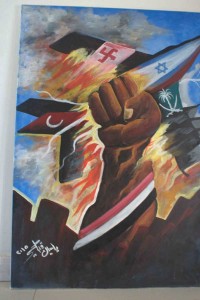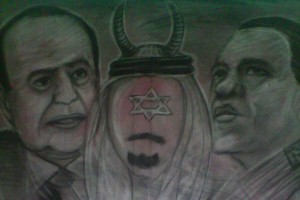[Sana’a] – Nowhere does the Mideast adage, “The enemy of my enemy is my friend,” resonate more than in Yemen’s fine arts community where artists are using their talents to paint more than pictures. Bright canvasses are telling the story of terror from the sky and the complicity of all those who support (or who are accused of supporting) what is referred to as “brute aggression.”
Vilified in the works of art through the use of national flags and other symbolisms prominent next to those of Saudi Arabia are the United States and Israel.
Artist Yasin Al-Qubaiti, for instance, drew a hand grabbing a coalition war plane adorned with US and Israeli flags, bombing the Noqum Mountain where arms depots are located. He explained that, “Israeli and American experts are helping the Saudis in their war against Yemen, and therefore they are as guilty as the Saudi regime.”
Another, drawn by artist Majid Al-Hamdani, depicts three Arab leaders he identifies as President Hadi of Yemen, King Salman of Saudi Arabia, and President Al-Sissi of Egypt. The Star of David is on the face of King Salman, “who was given horns to symbolize that he is the devil.” According to the artist, King Salman’s ancestor was a Jewish man, and therefore Salman himself is a Jew.
Speaking to artists in the capital Sana’a and elsewhere, The Media Line was told over and over that the driving emotion is opposition to the coalition which is destroying homes and cities, “so if that makes us pro-Saleh or anti-Hadi, so be it!” The reference to Saleh is former longtime strongman Ali Abdullah Saleh who is closely aligned with the Iranian-backed Shiite Houthis; while the reference to Hadi is the incumbent Abd Rabbo Mansour Hadi, who remains in exile in Riyadh even after most of his cabinet are returning to the southern port city of Aden after the coalition drove out the Houthi fighters.
The Houthis swept down from the north in September 2014, quickly overpowering the Hadi-loyal forces in the capital. In March, the Saudi-led coalition imposed an aerial and naval blockade that quickly escalated into systematic bombardment of Houthi positions, including those in heavily populated areas of Sana’a and in other key cities. Some 20 million Yemeni citizens were left in the grasp of a humanitarian crisis, needing food, water and medical aid. Emotionally, it left much of the population angry with the coalition since it was its aircraft that were destroying their homes.
Yemen’s fine arts community became an example of a sector using its special skills and talents to express outrage at the situation, “painting fingers” at those they see as being responsible for the carnage and the vast devastation being wrought upon the Yemeni people.
“It is natural for artists to be affected by the current condition in the country, it is a crisis situation from which the artist cannot separate himself,” Shefaa Al-Shuaibi, deputy general manager of General Fine Arts in Yemen, a member of “My Colors” international women artists alliance and recipient of the President’s Award for Creative Youth, told The Media Line. “Some artists have found much inspiration because of the current events, others have stopped painting altogether for the same reasons,” she said.
Al-Shuaibi explained that Yemen is currently suffering many kinds of obstacles including financial ones which have directly affected the field of fine arts in Yemen and has led to closing most studios, bringing the art scene in Yemen – the country once called “Arabia Felix” — almost into a complete halt. For that, the artists blame the coalition. Nevertheless, Al-Shuaibi optimistically proclaimed that, “Art will not die, it is just in a dormant condition right now due to the situation in Yemen.”
As artists have disappeared and new ones have emerged, they were divided between opponents and proponents of the Saudi Intervention. But with the Houthis still in control of Sana’a, those who oppose “the intervention” can freely voice their opinions and paint them with bright colors. As for those who support the Saudi initiative, they can barely leave their homes and return safely.
The Media Line visited The Forum for Arts and Culture, an art house where about a dozen male and female artists create and display their works and educational workshops are held. One artist explained that artists at The Forum oppose the Saudi intervention because it is targeting their livelihoods, infrastructure, families and sovereignty.
Forum founder Nabil Al-Badawi told The Media Line that, “We opened the Forum for Culture and Art early in March, two weeks before the war. Our goal was to group most of Yemen’s artists in one place, but after the war started, our goal became to unite all artists against the unjust Saudi war on Yemen.”
The Forum’s founders say they are supporting their country in the way they can, adding that they did not sell a single painting since they opened the Forum and they are in debt to their property owners.
Artists who are anti-Houthi but not necessarily pro-coalition have said that the Forum is open only because of their relationship with the Houthis.
Nevertheless, the Houthis arguably must approve of the prevalent anti-coalition message. Al-Badawi said, “We held our first exhibition in June, it aimed at exposing the Saudis crimes in Yemen, and we held it in The House of Culture in Sana’a, exhibiting 36 paintings from 10 artists including three female artists.”
Nabil Al-Badawi concluded that, “I am an artist, I can only paint to serve my country, I do not know how to use a weapon and neither do my colleagues. We only have our brushes which we use to create paintings that are sometimes worth ten diplomats.”
Meanwhile, on walls outside the Saudi Embassy in Sana’a, numerous hand-drawn images are appearing. Again, they depict the fight against the intervention and putative Saudi allies Israel and the United States.

